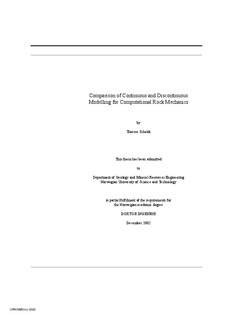| dc.description.abstract | Computational rock mechanics becomes more and more popular. New programs are constantly under development, and the modelling process has become a natural part of the planning process for many caverns and tunnels, as well as for the mining and petroleum industry.
Computational rock mechanics becomes more and more popular. New programs are constantly under development, and the modelling process has become a natural part of the planning process for many caverns and tunnels, as well as for the mining and petroleum industry.
When to use continuous modelling in preference to discontinuous modelling and vice versa, is an important question that has been discussed for a long time.
For this purpose, in this work continuous and discontinuous modelling is applied in order to analyze the stability of the Gjøvik Olympic Mountain Hall. The large span cavern (62m) was built in connection with the XVII Winter Olympic Games 1994 at Lillehammer, and is a unique case study because of the large amount of available input data from a comprehensive stress and deformation monitoring program carried out during and after the excavation, as well as thorough pre-investigations. Phase2, a two-dimensional non-linear finite element program, and the Discontinuous Deformation Analysis (DDA) are used as representative tools for continuous and discontinuous modelling, respectively. DDA is both a theory and a computer program. The modelling procedure is similar to the distinct element modelling, while it more closely parallels the finite element method with respect to: i) Minimizing the total potential energy to establish equilibrium equations, ii) Choosing displacements as unknowns of the simultaneous equations and iii) Adding stiffness, mass and loading submatrices to the coefficient matrix of the simultaneous equation.
In general, the decision to use either continuous or discontinuous modelling should be based on data from the geological field mapping process. Mapping techniques which remove subjectivity from the results, for example scanline/area mapping or semi-automatic mapping, are recommended. If the rock mass is basically free of discontinuities, or if the discontinuities are very closely spaced in comparison to the dimensions of the problem to be analysed, continuous modelling is preferable. If large deformations including slip, rotation and separation are dominant, as for rock slope stability problems, discontinuous modelling may be selected. If the problem to be analysed cannot be classified within one of the two groups, the quality of required input parameters and the purpose of the modelling should be taken into consideration.
For underground hard rock problems as the Gjøvik Olympic Mountain Hall, continuous modelling is strongly recommended. Today’s mapping techniques are not good enough to give satisfactory information about the required and most crucial input for discontinuous modelling, namely the joint pattern, and the process for implementation of measured discontinuities into a numerical model is based on too many approximations. In addition, the discontinuous modelling process is very time consuming. A fast and high capacity computer is required.
Crucial input parameters for continuous modelling are strength and deformability parameters of the rock mass, and estimation of these parameters is dependent on the selected failure criterion, usually either Mohr-Coulomb or Hoek-Brown.
The magnitude of in-situ stresses, particularly the horizontal stresses, may have crucial influence on the general stability, and independent of whether continuous or discontinuous modelling is selected, in-situ stress measurements are strongly recommended in order to estimate a reasonably correct stress level for the problem to be analysed.
It is very difficult to estimate reliable input parameters for numerical modelling and a critical evaluation of the analysis results is absolutely recommended. Thus, analysis results should be considered as valuable additional input to field observations, in-situ and laboratory measurements, and experience rather than a precise answer for the given problem. | nb_NO |
